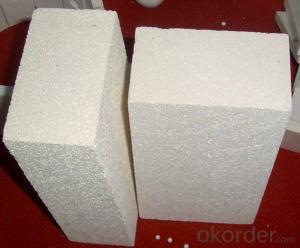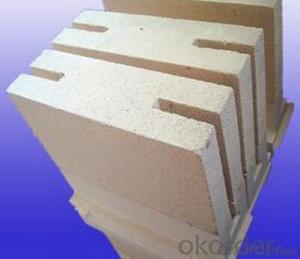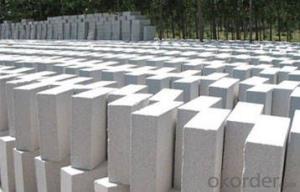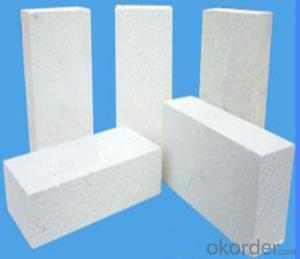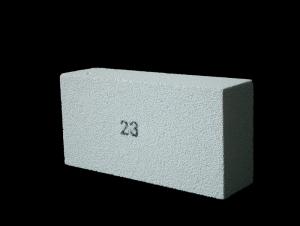Insulating Fire Brick - Refractory GJM Mullite Insulation Brick GJM-28
- Loading Port:
- Shanghai
- Payment Terms:
- TT OR LC
- Min Order Qty:
- 10 m.t.
- Supply Capability:
- 1000 m.t./month
OKorder Service Pledge
OKorder Financial Service
You Might Also Like
Specifications
mullite insulation brick
1. Low thermal conductivity
2.High hot compressive strength
3.Perfect Energy saving
Light weight mullite insulation furnace bricks refractory for sale
Advantage
1. Low thermal conductivity
2.High hot compressive strength
3.Perfect Energy saving
Description:
Lightweight mullite kiln bricks refractory for sale are made from good quality and superpure raw materials, with strictly classified fillings according to their grades. These fillings can form a uniform pore structure after burnt during the process of manufacture. Each grade of products has unique design to meet different thermal, physical and chomical demands.
Application:
Mullite insulation furnace bricks refractory material can be used in linings or heat-insulating materials of the industries, such as, ethylene pyrolysis furnaces, tubular furnaces, reforming furnaces of synthetic ammonia, gas generators and high-temperature shullte kilns, etc
Mullite Insulation furnace refractory material can be used as working lining, where contact with flames directly. This kind of brick can save the kiln energy very much
- Q: Can insulating fire bricks be used in the construction of ovens or kilns for pottery?
- Yes, insulating fire bricks can be used in the construction of ovens or kilns for pottery. These bricks are designed to withstand high temperatures and provide excellent insulation, making them suitable for creating a stable and efficient heat environment required for pottery firing.
- Q: Are insulating fire bricks resistant to phosphoric acid?
- Insulating fire bricks are generally not resistant to phosphoric acid. Phosphoric acid is a strong acid that can react with and corrode many materials, including fire bricks. While some fire bricks may have a certain level of resistance to acidic environments, it is unlikely that insulating fire bricks would be able to withstand prolonged exposure to phosphoric acid without significant deterioration. It is therefore recommended to use acid-resistant materials, such as acid-resistant bricks or linings, when dealing with phosphoric acid or other strong acids.
- Q: Can insulating fire bricks be used in high-velocity gas flow applications?
- Yes, insulating fire bricks can be used in high-velocity gas flow applications. Insulating fire bricks are designed to have excellent thermal insulation properties, low thermal conductivity, and high resistance to temperature fluctuations. These characteristics make them suitable for various high-temperature applications, including high-velocity gas flow environments. When exposed to high-velocity gas flow, insulating fire bricks can maintain their structural integrity and insulation properties, providing effective thermal insulation and protection. They are often used in applications such as kilns, furnaces, boilers, and other industrial equipment where high-velocity gas flow is present. However, it is important to consider the specific requirements and characteristics of the gas flow in the application. Factors such as temperature, pressure, and chemical composition of the gas should be taken into account to ensure that the insulating fire bricks are compatible and can withstand the conditions. In summary, insulating fire bricks can be used in high-velocity gas flow applications due to their thermal insulation properties and resistance to temperature fluctuations. However, it is crucial to consider the specific requirements and characteristics of the gas flow to ensure proper compatibility and performance.
- Q: What is the recommended thickness for insulating fire brick installations?
- The recommended thickness for insulating fire brick installations typically ranges from 2 to 4 inches.
- Q: Difference between inorganic insulation material and organic thermal insulation material
- 1, organic insulation material with light weight, good processability, high compactness, good insulation effect, but the disadvantage is: aging resistance, deformation coefficient, poor stability, poor security, easy combustion, ecological environmental protection is poor, difficult construction, construction cost is higher, and the limited resources. It is difficult to recycle.2, inorganic insulation materials with energy-saving, waste, heat insulation, fire protection, antifreeze, anti-aging and excellent performance, as well as low prices and other characteristics, can achieve A-level fire protection, has a wide range of market demand.
- Q: What is the typical lifespan of an insulating fire brick?
- The typical lifespan of an insulating fire brick can vary depending on several factors. These factors include the type and quality of the brick, the temperature and conditions it is exposed to, and the level of maintenance it receives. In general, insulating fire bricks are designed to withstand high temperatures and provide insulation in various industrial applications such as kilns, furnaces, and fireplaces. They are made from lightweight refractory materials that have good thermal insulation properties. With proper installation and regular maintenance, insulating fire bricks can last for many years. However, over time, exposure to extreme temperatures, thermal cycling, chemical corrosion, and mechanical stress can cause gradual wear and tear, leading to a decrease in their lifespan. On average, insulating fire bricks can typically last anywhere from 5 to 20 years. This range is quite broad due to the aforementioned factors. Bricks used in higher temperature applications or subjected to more severe conditions may have a shorter lifespan, while those in less demanding environments may last longer. To maximize the lifespan of insulating fire bricks, it is important to follow proper installation techniques, use bricks with the appropriate temperature rating for the application, and regularly inspect and maintain the bricks. This includes checking for cracks, erosion, or any signs of deterioration and promptly addressing any issues to prevent further damage. Overall, while there is no definite lifespan for insulating fire bricks, their longevity can be extended through proper care and maintenance, allowing them to provide effective insulation and serve their intended purpose for a significant period of time.
- Q: Can insulating fire bricks be used in the construction of hearths?
- Indeed, hearths can be constructed using insulating fire bricks. These bricks are specifically engineered to endure extreme temperatures, rendering them a superb selection for hearth construction. With their low thermal conductivity, they effectively retain heat and hinder the transmission of heat to nearby surroundings. Consequently, they are perfect for establishing a well-insulated and efficient hearth. Furthermore, their lightweight and manageable nature make them highly convenient for construction tasks. All in all, insulating fire bricks prove to be a dependable and pragmatic choice for the development of hearths.
- Q: Do insulating fire bricks require any special anchors or supports for installation?
- Yes, insulating fire bricks do require special anchors or supports for installation in certain applications. Insulating fire bricks are lightweight and have low thermal conductivity, making them ideal for use in high-temperature environments such as furnaces, kilns, and fireplaces. However, due to their lightweight nature, they can be prone to movement or displacement under certain conditions. To ensure the stability and integrity of the insulating fire bricks, it is recommended to use special anchors or supports during installation. These anchors or supports are typically made of metal, such as stainless steel, and are designed to securely hold the bricks in place. They help prevent the bricks from shifting or falling out, especially when exposed to vibrations, thermal expansion/contraction, or other external forces. The type and design of the anchors or supports depend on the specific application and installation requirements. Common types of anchors include V anchors, U anchors, and L anchors, which are embedded into the surrounding refractory material or attached to a structural frame. The anchors or supports should be properly spaced and installed according to the manufacturer's guidelines to ensure adequate support and stability of the insulating fire bricks. In summary, while insulating fire bricks offer excellent thermal insulation properties, they do require special anchors or supports for installation in order to prevent movement or displacement. These anchors or supports play a crucial role in maintaining the structural integrity and longevity of the insulating fire brick system.
- Q: Can insulating fire bricks be used in the construction of refractory coatings?
- Indeed, refractory coatings can utilize insulating fire bricks during their construction. The purpose of insulating fire bricks is to possess a low thermal conductivity, enabling them to effectively hinder the transfer of heat. Consequently, they prove to be an optimal choice for refractory coatings, which serve the purpose of shielding structures from elevated temperatures. Refractory coatings are applied onto surfaces that endure extreme heat, such as furnaces, kilns, and chimneys. These coatings furnish an insulating layer that aids in preserving heat, preventing harm to the underlying structure, and enhancing energy efficiency. In the construction of refractory coatings, insulating fire bricks can be employed as a foundational layer. They can be stacked and bonded together to form a sturdy and heat-resistant surface. This layer acts as a barrier that impedes the passage of heat to the underlying structure. Apart from their low thermal conductivity, insulating fire bricks possess other attributes that render them suitable for use in refractory coatings. They exhibit high temperature resistance, enabling them to withstand the intense heat generated in industrial applications. Furthermore, they boast a lightweight nature and are easy to handle, facilitating convenient installation and handling. To summarize, insulating fire bricks present themselves as a dependable choice when it comes to constructing refractory coatings. With their exceptional insulation properties and capacity to shield against high temperatures, they stand as a valuable component in the production of structures that can withstand extreme heat.
- Q: Are insulating fire bricks resistant to freeze-thaw cycles?
- Yes, insulating fire bricks are generally resistant to freeze-thaw cycles. These bricks are designed to have low thermal conductivity and high resistance to thermal shock, which makes them highly durable and capable of withstanding extreme temperature variations, including freeze-thaw cycles. This resistance to freeze-thaw cycles is crucial in applications where the bricks are exposed to fluctuating temperatures, such as in furnaces, kilns, and other high-temperature environments. The insulating properties of these bricks also help to minimize heat loss and prevent moisture penetration, further enhancing their resistance to freeze-thaw cycles. However, it is important to note that the specific composition and manufacturing process of the insulating fire bricks can vary, so it is always recommended to consult the manufacturer's specifications and guidelines to ensure the bricks are suitable for the intended application.
Send your message to us
Insulating Fire Brick - Refractory GJM Mullite Insulation Brick GJM-28
- Loading Port:
- Shanghai
- Payment Terms:
- TT OR LC
- Min Order Qty:
- 10 m.t.
- Supply Capability:
- 1000 m.t./month
OKorder Service Pledge
OKorder Financial Service
Similar products
Hot products
Hot Searches
Related keywords
